Diplomatic Bluebook 2023
Chapter 2
Japan's Foreign Policy by Region
4 Southeast Asia
(1) Indonesia
Indonesia is a major country in the Southeast Asia region with the fourth largest population in the world (at approximately 270 million people) and situated in a strategic location on sea lanes such as the Strait of Malacca. Indonesia plays a leading role in the Association of Southeast Asian Nations (ASEAN) and has often been taking the initiative in efforts to address various challenges in the regional and international community while serving as the sole G20 member from ASEAN.
President Joko's second administration, which started in October 2019, is a stable administration where the ruling parties coalition occupies approximately 82% of the seats in the House of Representatives. This administration's priorities are (1) infrastructure development, (2) human resources development, (3) investment promotion, (4) bureaucratic reforms, and (5) appropriate execution of the state budget. Indonesia's economic growth rate, which had consistently been maintained at around 5% in recent years, recorded negative growth in 2020 due to the impacts of COVID-19, but returned to positive growth of 3.6% in 2021. As a strategic partner, Japan is actively promoting cooperation in infrastructure development and human resources development, which are priorities of the second Joko administration.
Prime Minister Kishida visited Indonesia in April for the first time after assuming the office of Prime Minister, President Joko Widodo also visited Japan in July to hold a face-to-face summit meeting, and another bilateral summit meeting took place in November on the sidelines of the G20 Bali Summit. At the summit meeting in July, President Joko stated, regarding the import restriction imposed by Indonesia on Japanese food products after the Tokyo Electric Power Company (TEPCO)'s Fukushima Daiichi Nuclear Power Station Accident, that all import restrictions on Japanese food products had been lifted, thereby resulting in the complete elimination of the restrictions. Prime Minister Kishida also had a telephone call with President Joko in March and October. Foreign Minister Hayashi had a telephone call with Foreign Minister Retno Marsudi in February and November and had a face-to-face meeting in July. Given that Indonesia played an important role as the holder of the G20 presidency in 2022 and will chair ASEAN in 2023, the two countries closely exchanged views at these respective meetings on strengthening bilateral relations and working together to address various issues in the region and the international community.
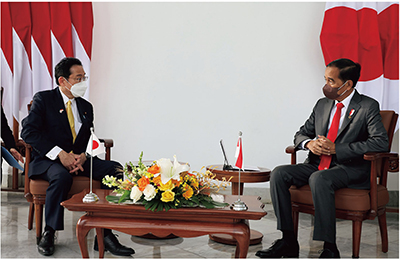 Japan-Indonesia Summit Meeting (April 29, Bogor, Indonesia; Photo: Cabinet Public Affairs Office)
Japan-Indonesia Summit Meeting (April 29, Bogor, Indonesia; Photo: Cabinet Public Affairs Office)(2) Cambodia
Cambodia, located in the Mekong region, is a key country in strengthening connectivity and narrowing the development gap in the region. Cambodia had been averaging approximately 7% growth for the past 20 years, and, although GDP growth in 2020 was negative due to the impacts of COVID-19, in 2021 it returned to positive growth at 3.0%
Japan has cooperated with Cambodia's peace, reconstruction, and development efforts, including in the first full-scale deployment of UN peacekeeping operations (PKO) in 1992. In recent years, Japan has also developed its economic ties with Cambodia as Japanese companies have expanded their operations within the country
At the Japan-Cambodia Summit Meeting in March, Prime Minister Kishida and Prime Minister Hun Sen released a Joint Statement indicating the direction of cooperation between Japan and Cambodia, and also confirmed that they would cooperate in regional and international arenas. At the Japan-Cambodia Summit Meeting in November, based on the progress in cooperation between the two countries, the two leaders concurred to upgrade their bilateral relationship to a “Comprehensive Strategic Partnership” on the occasion of the 70th anniversary of the establishment of diplomatic relations between Japan and Cambodia in 2023.
Regarding domestic affairs, the Cambodia National Rescue Party, the largest opposition party, was dissolved in 2017, and the ruling Cambodian People's Party monopolized all seats in the 2018 National Assembly elections. 17 political parties participated in the commune elections in June 2022, with the ruling party winning approximately 80% of the seats. As part of its efforts to boost Cambodia's democratic development, Japan has been supporting legal reform and implementing projects to promote dialogue between the government and civil society.
The Khmer Rouge Tribunal, which Japan has supported for many years, completed its judicial process in November 2022 with a ruling in appeals court case 002/02 (in which the former heads of state were the defendants).
(3) Singapore
Singapore is the most economically advanced country within ASEAN. Based on its omnidirectional foreign policy, the country maintains friendly relations with major countries including the U.S. and China.
In Singapore, the People's Action Party (PAP), led by Prime Minister Lee Hsien Loong, holds more than 90% of the seats from the 2020 general elections, and, with the basis of a stable political situation, is working to balance COVID-19 countermeasures and the economy, such as through rapid COVID-19 measures, economic measures, and the promotion of policies aimed at post-COVID-19 growth. In April, the PAP chose Minister of Finance Lawrence Wong as a candidate for the next Prime Minister.
In 2022, there were reciprocal visits at the summit and foreign ministers' level. Prime Minister Kishida visited Singapore in June and Foreign Minister Hayashi visited Singapore in October, while Prime Minister Lee Hsien Loong visited Japan in May and September and Foreign Minister Vivian Balakrishnan visited Japan in May. On these occasions, summit meetings and foreign ministers' meetings were held, and there were exchanges of views on further strengthening bilateral relations and on the various issues facing both the region and the international community. During Prime Minister Kishida's visit to Singapore in June, it was announced that negotiations would commence on the Agreement concerning the Transfer of Defense Equipment and Technology between the Government of Japan and the Government of the Republic of Singapore.
The two countries have worked together to provide developing countries with technical assistance through the “Japan-Singapore Partnership Program for the 21st Century (JSPP21),” which was signed in 1997. To date they have provided approximately 400 training courses with roughly 7,300 participants from ASEAN countries and other regions (as of the end of December 2022). The Japan Creative Centre (JCC), which was opened in Singapore in 2009 as a platform to promote Japanese culture, distributed a variety of information and held events while taking measures against COVID-19 infections.
(4) Thailand
Thailand is one of the original member states of ASEAN, which was born from the “Bangkok Declaration” in 1967. It is located in the center of the Mekong region and is a geopolitically important country. Thailand has become a major production center for Japanese companies, including the automobile industry, and today Thailand is an indispensable part of the Japanese economy as a part of the global supply chain, with close to 6,000 Japanese companies operating in Thailand and approximately 80,000 Japanese nationals living in Thailand.
2022 marked the 135th anniversary of diplomatic relations between Japan and Thailand. Since the formulation of the “Strategic Partnership” between Japan and Thailand in 2012, the two countries have deepened bilateral ties in a wide range of areas, and there were active high-level exchanges in 2022. Prime Minister Kishida visited Thailand in May, met with Prime Minister Prayut Chan-o-cha for the Japan-Thailand Summit Meeting, and signed the Agreement between the Government of Japan and the Government of the Kingdom of Thailand concerning the Transfer of Defense Equipment and Technology. Furthermore, Prime Minister Prayut visited Japan in May and met with Prime Minister Kishida for the Japan-Thailand Summit Meeting. In November, Foreign Minister Hayashi visited Thailand for the APEC Ministerial Meeting, held a Foreign Ministers' Meeting with Deputy Prime Minister and Foreign Minister Don Pramudwinai, and signed a “Five-Year Joint Action Plan on Japan-Thailand Strategic Economic Partnership” that charts out bilateral economic cooperation in the next 5 years. Based on the further expansion of bilateral relations like this, Prime Minister Kishida held a Japan-Thailand Summit Meeting with Prime Minister Prayut in November, and the two leaders concurred to elevate the bilateral relationship to a “Comprehensive Strategic Partnership.”
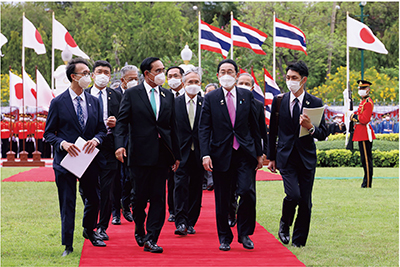 Welcome ceremony during Prime Minister Kishida's visit to Thailand (May 2, Bangkok, Thailand; Photo: Cabinet Public Affairs Office)
Welcome ceremony during Prime Minister Kishida's visit to Thailand (May 2, Bangkok, Thailand; Photo: Cabinet Public Affairs Office)Because of the implementation of border restriction measures due to the spread of COVID-19, Thailand's economy declined in 2020 and 2021 due to the decrease in the number of overseas tourists, etc. However, with the gradual easing of border restrictions in 2022, the number of tourists has steadily recovered, and in the second quarter (April to June) of 2022, Thailand's GDP level recovered to about 99% of its pre-COVID-19 level.
(5) Timor-Leste
Timor-Leste, the first country that achieved independence in the 21st century (in 2002), is strategically important in the Indo-Pacific region, and is situated in a critical sea lane between Australia and Indonesia. In 2022 the country celebrated the 20th anniversary of its independence, has realized peace and stability with the support of the international community, and has been building the nation based on democracy. Presidential elections were held in March and April, and President Ramos-Horta was elected. As its economy is highly dependent on natural resources such as petroleum and natural gas, the country has been working on industrial diversification as a matter of the highest national priority. On the diplomatic side, Timor-Leste is continuing to work in coordination with the relevant countries toward joining ASEAN and the WTO, and in November an agreement was reached in principle on Timor-Leste's ASEAN membership.
Japan established diplomatic relations with Timor-Leste upon its independence, and 2022 marks the 20th anniversary of the establishment of diplomatic relations between Japan and Timor-Leste. In 2022, Japan also conducted active face-to-face diplomacy with Timor-Leste. In May, Parliamentary Vice-Minister for Foreign Affairs MIYAKE Shingo attended the inauguration ceremony for President Ramos-Horta as a Special Envoy of Prime Minister Kishida, and made courtesy calls to and met with President Ramos-Horta, Prime Minister Taur Matan Ruak, and Minister of Foreign Affairs and Cooperation Adaljíza Magno. In August and September, Foreign Minister Hayashi held a Japan-Timor-Leste Foreign Ministers' Meetings with Minister of Foreign Affairs and Cooperation Magno, and the two Ministers exchanged views on bilateral relations and on various issues facing the region and the international community. Japan has continued to support Timor-Leste since even before its independence, and maintained good relations with the country. In 2022, Japan supported the restoration of infrastructure damaged by flooding and landslides in 2021, and has supported the training of young government officials. Furthermore, National Road No.1, which Japan supported via loan aid, was opened, with the inauguration ceremony being held in August.
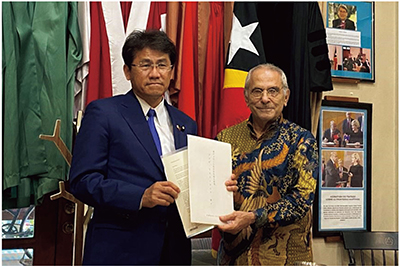 Parliamentary Vice-Minister for Foreign Affairs Miyake paying a courtesy call to President-elect Ramos-Horta as a Special Envoy of Prime Minister Kishida (May 18, Dili, Timor-Leste)
Parliamentary Vice-Minister for Foreign Affairs Miyake paying a courtesy call to President-elect Ramos-Horta as a Special Envoy of Prime Minister Kishida (May 18, Dili, Timor-Leste)(6) The Philippines
The Philippines is a maritime nation on Japan's sea lanes, and shares strategic interests with Japan. Although the Philippines' economy experienced negative growth in 2020 due to the impact of COVID-19, it achieved a V-shaped recovery with 5.6% growth in 2021, and it aims to achieve 6.5% to 8% annual growth going forward, and to become a middle-income country by 2024. President Ferdinand Marcos, who took office in June, won a landslide victory with the largest share of the vote in history, and is aiming for economic development and poverty reduction through agricultural development, tourism promotion, education reform, digital transformation, proactive infrastructure development, and energy security. As for the Mindanao Peace Process, despite the delays seen in the decommissioning and disarmament work with the Moro Islamic Liberation Front (MILF) due to COVID-19, based on the amended Bangsamoro Organic Law, the effort to conceive an autonomous government is continuing toward 2025.
Japan and the Philippines resumed visits by dignitaries, which had been interrupted due to the impact of COVID-19, beginning with visits by the Philippines' Foreign and Defense Ministers to Japan for the first Japan-Philippines Foreign and Defense Ministerial Meeting (“2+2”) in April. The two counties are further strengthening their Strategic Partnership, which marks its 11th year. As for relations with the Marcos administration, Prime Minister Kishida held a telephone call with President-elect Marcos in May, and Foreign Minister Hayashi attended President Marcos' inauguration ceremony in June as a Special Envoy of Prime Minister Kishida and paid a courtesy call to the President. Since then, a Japan-Philippines Summit Meeting was held in September, and Foreign Ministers' telephone calls were held in July and August, with active discussions on strengthening bilateral cooperation and on the regional situation. Vice President Rodrigo Duterte visited Japan for the state funeral for the late Prime Minister ABE Shinzo in September. In terms of economics, the 12th and 13th meetings of the Japan-Philippines High Level Joint Committee on Infrastructure Development and Economic Cooperation were held in February and November respectively, and discussions were held to render dynamic support for the Philippines to become a middle-income country and for its “Build Better More” infrastructure policy. Additionally, the deployment of Japanese personnel for the decommissioning and disarmament of the Mindanao Peace Process began in March, and the Subic Bay Regional Development Master Plan, which Japan helped formulate, was released in April.
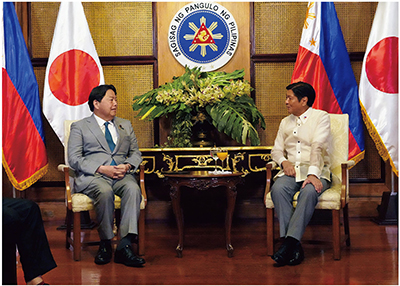 Foreign Minister Hayashi paying a courtesy call to President Marcos as a Special Envoy of Prime Minister Kishida (June 30, Manila, Philippines)
Foreign Minister Hayashi paying a courtesy call to President Marcos as a Special Envoy of Prime Minister Kishida (June 30, Manila, Philippines)(7) Brunei
Its abundance in natural resources has enabled Brunei to realize a high economic standard and generous social welfare. As such, the country enjoys political and economic stability. Although it is a constitutional monarchy and has a Legislative Council, the Sultan concurrently serves as the Prime Minister, Minister of Finance and Economy, Minister of Defence and Minister of Foreign Affairs, and therefore holds an impressively strong authority. Located in the center of Southeast Asia, the country is one of the claimant countries in the South China Sea and has adopted a balanced diplomacy built on the pillar of promoting ASEAN unity and centrality.
Although it recorded an economic growth rate of 1.1% in 2020, Brunei had a negative economic growth rate in 2021 due to the impact of COVID-19. Brunei's economy is supported by rising oil prices and operations via a joint oil refining venture with China, but the Government of Brunei is aiming for economic diversification to avoid overreliance on energy resources.
Japan and Brunei established diplomatic relations in 1984, and the two countries have developed excellent bilateral relations in various areas. In 2022, Foreign Minister Hayashi held a Japan-Brunei Foreign Ministers' Meeting with Minister for Foreign Affairs II Dato Erywan, and the two Ministers exchanged views on bilateral cooperation and on various issues facing the region and the international community. Moreover, Japan and Brunei are continuing to build a close relationship between the imperial and royal families, as His Majesty Sultan Haji Hassanal Bolkiah attended the Ceremony of the Enthronement of His Majesty the Emperor in 2019 and Her Royal Highness Princess Hajah Masna (Ambassador-at-Large at the Ministry of Foreign Affairs) attended the state funeral for the late Prime Minister ABE Shinzo in September, 2022. Brunei is an important country for the stable energy supply to Japan. Around 70% of Brunei's liquefied natural gas (LNG) exports are bound for Japan, and LNG from Brunei makes up around 5% of the total LNG import to Japan.
(8) Viet Nam
Located next to sea lanes in the South China Sea and sharing a long border with China, Viet Nam is a geopolitically important country. Given that the country embraces the third largest population in Southeast Asia, and is experiencing a surge in the number of people in middle-income brackets, Viet Nam is a promising market. The country is currently striving to achieve stable economic growth through the stabilization of the macroeconomy including control of inflation, the promotion of foreign investment by the development of infrastructure and the improvement of the investment environment. Viet Nam's economic growth rate from 2020 to 2021 fell to around the 2% level due to severe lockdowns caused by the spread of COVID-19, but, in2022, achieved an economic growth rate of 8.02% due to the shift to a “living with COVID-19” policy.
Japan and Viet Nam have been advancing cooperation in a variety of areas under the Extensive Strategic Partnership for Peace and Prosperity in Asia. In May, Prime Minister Kishida visited Viet Nam and held a Japan-Viet Nam Summit Meeting. At the meeting, the two leaders affirmed to (a) promote cooperation in the security field through capacity building assistance to the Vietnamese military in the area of cyber security, among others, (b)promote economic cooperation including the diversification of supply chains, digital transformation, and technological innovation, (c) establish a platform for dispatching technical intern trainees, and (d) cooperate to support enhancing disaster prevention capacity through the launch of an earth observation satellite. There have also been active high-level exchanges between the two countries, such as the September visit to Japan by President Nguyen Xuan Phuc and Ms. Truong Thi Mai, Chairwoman of the Viet Nam – Japan Parliamentary Friendship Association. The number of Vietnamese residing in Japan, primarily technical intern trainees, is also increasing, from approximately 40,000 in 2011 to over 430,000 by the end of December 2021, making Vietnamese nationals the second largest number of foreign residents in Japan by country after China. The Treaty between Japan and the Socialist Republic of Viet Nam on Mutual Legal Assistance in Criminal Matters also took effect in August 2022, and it is expected that more substantial legal assistance will be implemented in the future.
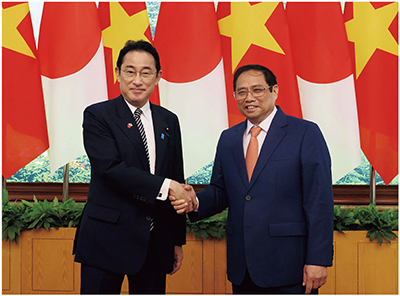 Japan-Viet Nam Summit Meeting (May 1, Hanoi, Viet Nam; Photo: Cabinet Public Affairs Office)
Japan-Viet Nam Summit Meeting (May 1, Hanoi, Viet Nam; Photo: Cabinet Public Affairs Office)(9) Malaysia
Comprised of the Peninsular Malaysia of the Malay Peninsula and the East Malaysia of Borneo, Malaysia is a geopolitically important country facing the South China Sea and the Strait of Malacca that is situated in a crucial spot in the Indian and Pacific Ocean. Furthermore, it is a federal state comprised of 13 states and three federal territories, and also a multiethnic state comprised of Bumiputra (Malay including indigenous peoples) (70%), Chinese (22%) and Indian people (7%), among others.
The Ismail Sabri administration, which was inaugurated in August 2021, focused on post-COVID-19 economic recovery while stabilizing domestic affairs, but as a result of the general election held in November 2022, the Anwar administration took office.
On the occasion of the 60th anniversary of the establishment of diplomatic relations between Japan and Malaysia and the 40th anniversary of the Look East Policy in 2022, former Prime Minister ABE Shinzo visited Malaysia in March as a Special Envoy of Prime Minister Kishida. The two countries have strengthened bilateral relations through the May visit to Japan by Prime Minister Ismail Sabri and five of his Cabinet Ministers, including Foreign Minister Saifuddin Abdullah, and the October visit to Malaysia by Foreign Minister Hayashi, and during these visits there were exchanges of views on cooperation between the two countries and on various issues facing the region and the international community.
In the field of human resources development, through the Look East Policy, which serves as a foundation for the good bilateral relationship between Japan and Malaysia and was begun by Prime Minister Mahathir in 1982, more than 26,000 Malaysian people have studied or have been trained in Japan so far. In 2022, numerous events were held to commemorate the 40th anniversary of the policy, and discussions and initiatives were held to ensure that the policy continues to develop to effectively meet the needs of the times. The two countries have been cooperating in making the Malaysia Japan International Institute of Technology (MJIIT), which was opened in September 2011, a base for Japanese-style engineering education in ASEAN countries. In addition, discussions are being held to establish a branch campus of the University of Tsukuba in Malaysia, and, if realized, it will be the first overseas branch campus to be established by a Japanese university. On the economic front, roughly 1,600 Japanese companies have been operating in Malaysia, which demonstrates a continued close relationship between the two countries.
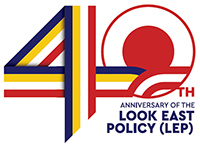 Official logo for the 40th anniversary of the Look East Policy
Official logo for the 40th anniversary of the Look East Policy(10) Myanmar
Since the coup d'état by the Myanmar military on February 1, 2021, many civilians have died as a result of armed suppression by the Myanmar security authorities, and in some areas, there have been intermittent clashes between the Myanmar military and ethnic armed organizations, the People's Defense Forces (PDF) and others. On the political front, there have been executions of Myanmar citizens, including pro-democracy activists in July, and Aung San Suu Kyi was convicted for a total of 33 years in prison, while on the economic front, there was turmoil caused by the forced conversion of foreign currency in April, and as such, the situation is deteriorating. On February 1, 2022, one year after the coup d'état, the Government of Japan released a statement by Foreign Minister Hayashi that expressed concern about the continued lack of action to improve the situation, and once again strongly urged the Myanmar military to take concrete actions to (1) immediately stop the violence, (2) release those who are detained, and (3) swiftly restore Myanmar's democratic political system. In addition, when the aforementioned executions were carried out, the Government of Japan released a statement by Foreign Minister Hayashi, stating that Japan seriously deplores these actions by the Myanmar military to completely go against the “release of the detainees,” which Japan has consistently called for. Furthermore, a joint statement with like-minded countries and a G7 Foreign Ministers' Statement were also issued. In order to break out of the current situation, Japan has been cooperating with the international community and giving maximum support to ASEAN's efforts, including Cambodia, as ASEAN Chair, based on the belief that it is important to achieve concrete results, especially ASEAN's “Five-Point Consensus.”26
At the UN, Japan has been cooperating with the international community joining each consensus on Human Rights Council resolutions (on the situation in Myanmar) in April and July, participating as a co-sponsor of the resolution in April, and co-sponsoring a resolution in November at the United Nations General Assembly Third Committee.
In terms of humanitarian assistance, on January 30 the United Nations Office for the Coordination of Humanitarian Affairs (OCHA) in Myanmar announced the Myanmar Humanitarian Response Plan 2022, which aims to support 6.2 million people in urgent need among 14.4 million in humanitarian need, out of the population of 54 million people in Myanmar. In response to this, on February 8, the Government of Japan announced that, through international organizations and the ASEAN Secretariat, it would provide humanitarian assistance totaling approximately 18.5 million US dollars to provide food, daily necessities, and medical supplies, etc., to people in Myanmar in need, and on April 1, Japan announced emergency grant aid totally 8.3 million US dollars to support internally displaced persons, mainly in the southeast and northwest of the country. So far, in order to improve the humanitarian situation in Myanmar, which continues to deteriorate, the Government of Japan has provided a total of more than 47 million US dollars in humanitarian assistance through international organizations and the ASEAN Coordinating Centre for Humanitarian Assistance on Disaster Management (AHA Centre) since the coup d'état on February 1, 2021. Japan will continue to actively provide humanitarian assistance in order to stand by the people of Myanmar who are facing difficulties.
- 26 The Five-Point Consensus was announced at the ASEAN Leaders' Meeting held on April 24, 2021. It calls for (1) immediate cessation of violence, (2) commencement of constructive dialogue among all parties concerned, (3) mediation of the dialogue process by a special envoy of the ASEAN Chair, (4) providing humanitarian assistance through the AHA Centre, and (5) visiting Myanmar to meet with all parties concerned by the special envoy and delegation.
(11) Laos
Laos is a landlocked country bordering all of the countries in the Mekong region, and therefore is a key country for Mekong connectivity. In domestic affairs in 2022, one year has passed since the 11th Congress of the Lao People's Revolutionary Party (LPRP) and election of members for the 9th National Assembly. In addition to changes such as the promotion of Minister of Foreign Affairs Saleumxay Kommasith to Deputy Prime Minister and Minister of Foreign Affairs, as well as changes in Cabinet Ministers, Prime Minister Phankham Viphavanh retired in December due to health problems, and Deputy Prime Minister Sonexay Siphandone was appointed as the new Prime Minister. Economically, Laos' economic growth rate, which fell to 0.5% in 2020 due to the impact of COVID-19, recovered to 2.5% in 2021, but in 2022 sharp inflation, fuel shortages, and price hikes due to the international situation were major stumbling blocks that affected the people's lives. Efforts to stabilize public finances, which is the top priority for the Government of Laos, include implementing a national agenda on economic and fiscal issues, and will continue to be required.
Prime Minister Phankham visited Japan in April for a Japan-Laos Summit Meeting, and in August a Japan-Laos Foreign Ministers' Meeting was held in Phnom Penh, Cambodia. At both meetings, it was confirmed that the two countries would further expand their Strategic Partnership in the lead up to the 50th anniversary of ASEAN-Japan friendship and cooperation in 2023 and the 70th anniversary of the establishment of diplomatic relations between Japan and Laos in 2025.
In July, Japan's Ministry of Justice, Ministry of Foreign Affairs, Ministry of Health, Labour and Welfare, and National Police Agency and Laos' Ministry of Labour and Social Welfare exchanged a memorandum of cooperation regarding residence status for “Specified Skilled Workers.” Furthermore, in August, a handover ceremony was held for the Nam Ngum 1 Hydropower Station Expansion Project, leaving an impression of Japan's long-standing contributions to the power plant, which is depicted on the national emblem of Laos. In response to both countries easing border measures, Deputy Prime Minister Sonexay, Head of Central Committee for Organization and Personnel Sysay Leudetmounsone, Minister of Energy and Mines Daovong Phonekeo, and Minister of Planning and Investment Khamjane Vongphosy successively visited Japan, and from Japan, in December State Minister for Foreign Affairs TAKEI Shunsuke visited Laos. Furthermore, momentum for the promotion of trade and investment between the two countries has increased through the holding of Laos investment promotion seminars and the dispatch of business missions from both sides.
Trade: Since 2001, Trade between Southeast Asia and China has dramatically increased. In the mid-2000s, China overtook the U.S. as an export destination for the region, but in recent years exports to the U.S., primarily from Viet Nam, have increased again. On the other hand, although Japan was once the primary export destination for the region, its share has continued to decline over the long term. In 2021, Japan ranked third in terms of its share in the region's exports, and second in terms of imports.2
Investment: The U.S. has the largest share of Foreign Direct Investment (FDI) in the region, mainly due to investment in Singapore. Japan's share of FDI in the region has been declining slightly in recent years, but it has maintained its presence primarily through investment in Thailand and the Philippines. Over the past few years China's share of FDI in the region has increased. Singapore, a high-income country in the region, has also been heavily investing in neighboring countries.
Finance: Although in recent years some countries in Southeast Asia have increased the amount of external debt that they owe to China, Japan has a significantly large presence in the region as a whole and is the largest bilateral creditor country.
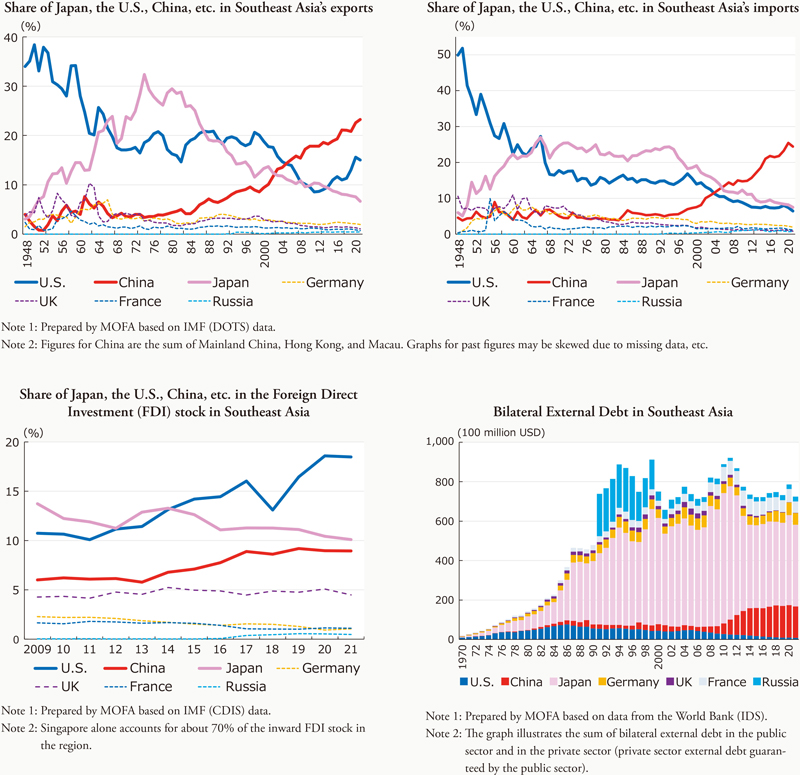
- 1. See page 193 for notes regarding this data.
- 2. While only a limited number of countries such as Japan, the U.S., and China are illustrated in the chart, the rankings in the text are for all countries/regions for which data is available (including countries, etc., in the relevant region).

